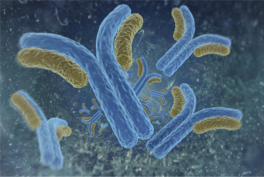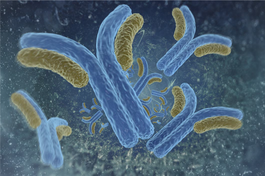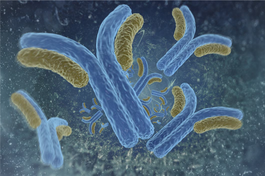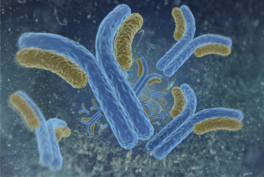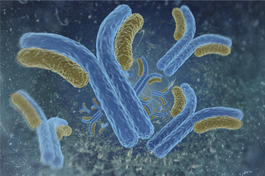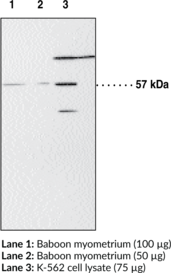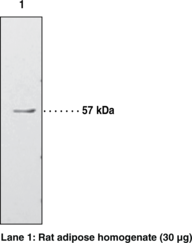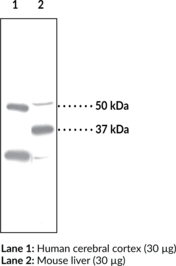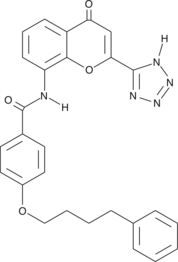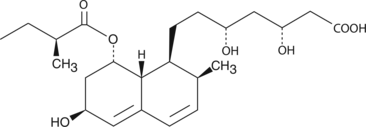Cayman
Showing 35701–35850 of 45550 results
-
PP1 is a potent, reversible, ATP-competitive, and selective inhibitor of the Src family of protein tyrosine kinases. It inhibits p56lck (IC50 = 5 nM), p59fynT (IC50 = 6 nM), Hck (IC50 = 20 nM), and Src (IC50 = 170 nM) without significantly affecting the activity of EGFR kinase (IC50 = 250 nM), JAK2 (IC50 = 50 µM), or ZAP-70 (IC50 ≥ 0.6 µM).{18539} PP1 inhibits anti-CD3-induced tyrosine phosphorylation of human T cells with an IC50 value of 600 nM.{18539} It exhibits antitumor activity by antagonizing both proliferation and the inhibition of apoptosis mediated by a stem cell factor/mast cell growth factor in hematopoietic and small cell lung cancer cell lines.{22348,22349} PP1 also blocks TGF-β-mediated cellular responses by directly inhibiting type I TGF-β receptors (IC50 = 50 nM) in a manner unrelated to Src signaling.{22347}
Brand:CaymanSKU:- -
PP1 is a potent, reversible, ATP-competitive, and selective inhibitor of the Src family of protein tyrosine kinases. It inhibits p56lck (IC50 = 5 nM), p59fynT (IC50 = 6 nM), Hck (IC50 = 20 nM), and Src (IC50 = 170 nM) without significantly affecting the activity of EGFR kinase (IC50 = 250 nM), JAK2 (IC50 = 50 µM), or ZAP-70 (IC50 ≥ 0.6 µM).{18539} PP1 inhibits anti-CD3-induced tyrosine phosphorylation of human T cells with an IC50 value of 600 nM.{18539} It exhibits antitumor activity by antagonizing both proliferation and the inhibition of apoptosis mediated by a stem cell factor/mast cell growth factor in hematopoietic and small cell lung cancer cell lines.{22348,22349} PP1 also blocks TGF-β-mediated cellular responses by directly inhibiting type I TGF-β receptors (IC50 = 50 nM) in a manner unrelated to Src signaling.{22347}
Brand:CaymanSKU:- -
PP1 is a potent, reversible, ATP-competitive, and selective inhibitor of the Src family of protein tyrosine kinases. It inhibits p56lck (IC50 = 5 nM), p59fynT (IC50 = 6 nM), Hck (IC50 = 20 nM), and Src (IC50 = 170 nM) without significantly affecting the activity of EGFR kinase (IC50 = 250 nM), JAK2 (IC50 = 50 µM), or ZAP-70 (IC50 ≥ 0.6 µM).{18539} PP1 inhibits anti-CD3-induced tyrosine phosphorylation of human T cells with an IC50 value of 600 nM.{18539} It exhibits antitumor activity by antagonizing both proliferation and the inhibition of apoptosis mediated by a stem cell factor/mast cell growth factor in hematopoietic and small cell lung cancer cell lines.{22348,22349} PP1 also blocks TGF-β-mediated cellular responses by directly inhibiting type I TGF-β receptors (IC50 = 50 nM) in a manner unrelated to Src signaling.{22347}
Brand:CaymanSKU:- -
PP1 is a potent, reversible, ATP-competitive, and selective inhibitor of the Src family of protein tyrosine kinases. It inhibits p56lck (IC50 = 5 nM), p59fynT (IC50 = 6 nM), Hck (IC50 = 20 nM), and Src (IC50 = 170 nM) without significantly affecting the activity of EGFR kinase (IC50 = 250 nM), JAK2 (IC50 = 50 µM), or ZAP-70 (IC50 ≥ 0.6 µM).{18539} PP1 inhibits anti-CD3-induced tyrosine phosphorylation of human T cells with an IC50 value of 600 nM.{18539} It exhibits antitumor activity by antagonizing both proliferation and the inhibition of apoptosis mediated by a stem cell factor/mast cell growth factor in hematopoietic and small cell lung cancer cell lines.{22348,22349} PP1 also blocks TGF-β-mediated cellular responses by directly inhibiting type I TGF-β receptors (IC50 = 50 nM) in a manner unrelated to Src signaling.{22347}
Brand:CaymanSKU:- -
PP121 is a potent dual inhibitor of tyrosine and phosphoinositide kinases with IC50 values ranging from 2 to 60 nM for p110α, mTOR, Src, Abl, and VEGFR.{17883} It demonstrates >90% inhibition of tyrosine kinases and 50 = 50 nM) in vitro. It blocks VEGF-driven human umbilical vein endothelial cell (HUVEC) tube formation (IC50 = 0.31 nM), an in vitro model of tumor angiogenesis. PP121 also inhibits MEKK2/MAP3K2 (IC50 = 31 nM), a kinase important for tumor growth and metastasis.{38183}
Brand:CaymanSKU:21196 -Out of stock
-
PP121 is a potent dual inhibitor of tyrosine and phosphoinositide kinases with IC50 values ranging from 2 to 60 nM for p110α, mTOR, Src, Abl, and VEGFR.{17883} It demonstrates >90% inhibition of tyrosine kinases and 50 = 50 nM) in vitro. It blocks VEGF-driven human umbilical vein endothelial cell (HUVEC) tube formation (IC50 = 0.31 nM), an in vitro model of tumor angiogenesis. PP121 also inhibits MEKK2/MAP3K2 (IC50 = 31 nM), a kinase important for tumor growth and metastasis.{38183}
Brand:CaymanSKU:21196 -Out of stock
-
PP121 is a potent dual inhibitor of tyrosine and phosphoinositide kinases with IC50 values ranging from 2 to 60 nM for p110α, mTOR, Src, Abl, and VEGFR.{17883} It demonstrates >90% inhibition of tyrosine kinases and 50 = 50 nM) in vitro. It blocks VEGF-driven human umbilical vein endothelial cell (HUVEC) tube formation (IC50 = 0.31 nM), an in vitro model of tumor angiogenesis. PP121 also inhibits MEKK2/MAP3K2 (IC50 = 31 nM), a kinase important for tumor growth and metastasis.{38183}
Brand:CaymanSKU:21196 -Out of stock
-
PP121 is a potent dual inhibitor of tyrosine and phosphoinositide kinases with IC50 values ranging from 2 to 60 nM for p110α, mTOR, Src, Abl, and VEGFR.{17883} It demonstrates >90% inhibition of tyrosine kinases and 50 = 50 nM) in vitro. It blocks VEGF-driven human umbilical vein endothelial cell (HUVEC) tube formation (IC50 = 0.31 nM), an in vitro model of tumor angiogenesis. PP121 also inhibits MEKK2/MAP3K2 (IC50 = 31 nM), a kinase important for tumor growth and metastasis.{38183}
Brand:CaymanSKU:21196 -Out of stock
-
The Src family of non-receptor tyrosine kinases regulate cell adhesion, growth, and differentiation through activation of multiple intracellular signaling pathways. Normally inactive, Src kinases are transiently activated during mitosis and constitutively activated by abnormal mutations. PP2 is a potent, reversible, ATP-competitive, and selective inhibitor of the Src family of protein tyrosine kinases. It inhibits p56lck (IC50 = 4 nM), p59fynT (IC50 = 5 nM), Hck (IC50 = 5 nM), and Src (IC50 = 100 nM).{18539} PP2 does not significantly affect the activity of EGFR kinase (IC50 = 480 nM), JAK2 (IC50 > 50 µM), or ZAP-70 (IC50 > 100 µM).{18539} PP2 inhibits the activation of focal adhesion kinase as well as its phosphorylation at Tyr577. PP2 also inhibits anti-CD3-stimulated tyrosine phosphorylation of human T-cells with an IC50 value of 600 nM.{18539}
Brand:CaymanSKU:- -
The Src family of non-receptor tyrosine kinases regulate cell adhesion, growth, and differentiation through activation of multiple intracellular signaling pathways. Normally inactive, Src kinases are transiently activated during mitosis and constitutively activated by abnormal mutations. PP2 is a potent, reversible, ATP-competitive, and selective inhibitor of the Src family of protein tyrosine kinases. It inhibits p56lck (IC50 = 4 nM), p59fynT (IC50 = 5 nM), Hck (IC50 = 5 nM), and Src (IC50 = 100 nM).{18539} PP2 does not significantly affect the activity of EGFR kinase (IC50 = 480 nM), JAK2 (IC50 > 50 µM), or ZAP-70 (IC50 > 100 µM).{18539} PP2 inhibits the activation of focal adhesion kinase as well as its phosphorylation at Tyr577. PP2 also inhibits anti-CD3-stimulated tyrosine phosphorylation of human T-cells with an IC50 value of 600 nM.{18539}
Brand:CaymanSKU:- -
The Src family of non-receptor tyrosine kinases regulate cell adhesion, growth, and differentiation through activation of multiple intracellular signaling pathways. Normally inactive, Src kinases are transiently activated during mitosis and constitutively activated by abnormal mutations. PP2 is a potent, reversible, ATP-competitive, and selective inhibitor of the Src family of protein tyrosine kinases. It inhibits p56lck (IC50 = 4 nM), p59fynT (IC50 = 5 nM), Hck (IC50 = 5 nM), and Src (IC50 = 100 nM).{18539} PP2 does not significantly affect the activity of EGFR kinase (IC50 = 480 nM), JAK2 (IC50 > 50 µM), or ZAP-70 (IC50 > 100 µM).{18539} PP2 inhibits the activation of focal adhesion kinase as well as its phosphorylation at Tyr577. PP2 also inhibits anti-CD3-stimulated tyrosine phosphorylation of human T-cells with an IC50 value of 600 nM.{18539}
Brand:CaymanSKU:- -
The Src family of non-receptor tyrosine kinases regulate cell adhesion, growth, and differentiation through activation of multiple intracellular signaling pathways. Normally inactive, Src kinases are transiently activated during mitosis and constitutively activated by abnormal mutations. PP2 is a potent, reversible, ATP-competitive, and selective inhibitor of the Src family of protein tyrosine kinases. It inhibits p56lck (IC50 = 4 nM), p59fynT (IC50 = 5 nM), Hck (IC50 = 5 nM), and Src (IC50 = 100 nM).{18539} PP2 does not significantly affect the activity of EGFR kinase (IC50 = 480 nM), JAK2 (IC50 > 50 µM), or ZAP-70 (IC50 > 100 µM).{18539} PP2 inhibits the activation of focal adhesion kinase as well as its phosphorylation at Tyr577. PP2 also inhibits anti-CD3-stimulated tyrosine phosphorylation of human T-cells with an IC50 value of 600 nM.{18539}
Brand:CaymanSKU:- -
The mammalian target of rapamycin (mTOR) is a serine-threonine kinase that is central to two protein complexes, mTORC1 and mTORC2. These complexes are differentially regulated (e.g., only mTORC1 is sensitive to rapamycin) and regulate different pathways. PP242 is an inhibitor of the active site of mTOR kinase in both mTORC1 and mTORC2 (IC50 = 8 nM).{17883,19367} It less effectively inhibits PKCα, PI3-kinase subunit p110γ, JAK2, PKCβI, and PKCβII (IC50 = 49, 102, 110, 198, and 185, respectively).{19367,19883} PP242 has been shown to cause the death of certain human and murine leukemia cells more potently than rapamycin and, in vivo, delays leukemia onset and augments the effects of tyrosine kinase inhibitors in suppressing leukemic expansion and extending survival.{18005}
Brand:CaymanSKU:- -
The mammalian target of rapamycin (mTOR) is a serine-threonine kinase that is central to two protein complexes, mTORC1 and mTORC2. These complexes are differentially regulated (e.g., only mTORC1 is sensitive to rapamycin) and regulate different pathways. PP242 is an inhibitor of the active site of mTOR kinase in both mTORC1 and mTORC2 (IC50 = 8 nM).{17883,19367} It less effectively inhibits PKCα, PI3-kinase subunit p110γ, JAK2, PKCβI, and PKCβII (IC50 = 49, 102, 110, 198, and 185, respectively).{19367,19883} PP242 has been shown to cause the death of certain human and murine leukemia cells more potently than rapamycin and, in vivo, delays leukemia onset and augments the effects of tyrosine kinase inhibitors in suppressing leukemic expansion and extending survival.{18005}
Brand:CaymanSKU:- -
The mammalian target of rapamycin (mTOR) is a serine-threonine kinase that is central to two protein complexes, mTORC1 and mTORC2. These complexes are differentially regulated (e.g., only mTORC1 is sensitive to rapamycin) and regulate different pathways. PP242 is an inhibitor of the active site of mTOR kinase in both mTORC1 and mTORC2 (IC50 = 8 nM).{17883,19367} It less effectively inhibits PKCα, PI3-kinase subunit p110γ, JAK2, PKCβI, and PKCβII (IC50 = 49, 102, 110, 198, and 185, respectively).{19367,19883} PP242 has been shown to cause the death of certain human and murine leukemia cells more potently than rapamycin and, in vivo, delays leukemia onset and augments the effects of tyrosine kinase inhibitors in suppressing leukemic expansion and extending survival.{18005}
Brand:CaymanSKU:- -
The mammalian target of rapamycin (mTOR) is a serine-threonine kinase that is central to two protein complexes, mTORC1 and mTORC2. These complexes are differentially regulated (e.g., only mTORC1 is sensitive to rapamycin) and regulate different pathways. PP242 is an inhibitor of the active site of mTOR kinase in both mTORC1 and mTORC2 (IC50 = 8 nM).{17883,19367} It less effectively inhibits PKCα, PI3-kinase subunit p110γ, JAK2, PKCβI, and PKCβII (IC50 = 49, 102, 110, 198, and 185, respectively).{19367,19883} PP242 has been shown to cause the death of certain human and murine leukemia cells more potently than rapamycin and, in vivo, delays leukemia onset and augments the effects of tyrosine kinase inhibitors in suppressing leukemic expansion and extending survival.{18005}
Brand:CaymanSKU:- -
The Src family of non-receptor tyrosine kinases regulate cell adhesion, growth, and differentiation through activation of multiple intracellular signaling pathways. Normally inactive, Src kinases are transiently activated during mitosis and constitutively activated by abnormal mutations. Several small molecule inhibitors of this signaling pathway have been developed as a therapeuptic strategy to abate abnormal Src kinase activity. PP3 is an inactive analog of the Src tyrosine kinase inhibitors PP1 (Item No. 14244) and PP2 (Item No. 13198). At concentrations as high as 10 μM, it does not prevent proliferation mediated by a stem cell factor/mast cell growth factor in hematopoietic and cancer cell lines.{22347,22349}
Brand:CaymanSKU:- -
The Src family of non-receptor tyrosine kinases regulate cell adhesion, growth, and differentiation through activation of multiple intracellular signaling pathways. Normally inactive, Src kinases are transiently activated during mitosis and constitutively activated by abnormal mutations. Several small molecule inhibitors of this signaling pathway have been developed as a therapeuptic strategy to abate abnormal Src kinase activity. PP3 is an inactive analog of the Src tyrosine kinase inhibitors PP1 (Item No. 14244) and PP2 (Item No. 13198). At concentrations as high as 10 μM, it does not prevent proliferation mediated by a stem cell factor/mast cell growth factor in hematopoietic and cancer cell lines.{22347,22349}
Brand:CaymanSKU:- -
The Src family of non-receptor tyrosine kinases regulate cell adhesion, growth, and differentiation through activation of multiple intracellular signaling pathways. Normally inactive, Src kinases are transiently activated during mitosis and constitutively activated by abnormal mutations. Several small molecule inhibitors of this signaling pathway have been developed as a therapeuptic strategy to abate abnormal Src kinase activity. PP3 is an inactive analog of the Src tyrosine kinase inhibitors PP1 (Item No. 14244) and PP2 (Item No. 13198). At concentrations as high as 10 μM, it does not prevent proliferation mediated by a stem cell factor/mast cell growth factor in hematopoietic and cancer cell lines.{22347,22349}
Brand:CaymanSKU:- -
PPA is the product of peroxidase-catalyzed reduction of PPHP. It can be used as a reference standard for HPLC analysis of peroxidase assays.{1054,1073}
Brand:CaymanSKU:75751 - 1 mgAvailable on backorder
-
PPA is the product of peroxidase-catalyzed reduction of PPHP. It can be used as a reference standard for HPLC analysis of peroxidase assays.{1054,1073}
Brand:CaymanSKU:75751 - 10 mgAvailable on backorder
-
PPA is the product of peroxidase-catalyzed reduction of PPHP. It can be used as a reference standard for HPLC analysis of peroxidase assays.{1054,1073}
Brand:CaymanSKU:75751 - 5 mgAvailable on backorder
-
PPA is the product of peroxidase-catalyzed reduction of PPHP. It can be used as a reference standard for HPLC analysis of peroxidase assays.{1054,1073}
Brand:CaymanSKU:75751 - 500 µgAvailable on backorder
-
Kallikreins are a class of serine proteases that affect the release of vasodepressor peptides or kinins from a plasma substrate. PPACKII is a specific and irreversible inhibitor of glandular and plasma kallikreins.{24966} At micromolar concentrations it has been shown to prevent apolipoprotein proteolysis in dextran sulfate-precipitated human plasma LDL and to inhibit serum atrial natriuretic peptide cleavage.{2805} PPACKII has also been reported to inactivate the amidolytic activity of native human Hageman Factor (Factor XII) at 5.3 μM.{24967}
Brand:CaymanSKU:- -
Kallikreins are a class of serine proteases that affect the release of vasodepressor peptides or kinins from a plasma substrate. PPACKII is a specific and irreversible inhibitor of glandular and plasma kallikreins.{24966} At micromolar concentrations it has been shown to prevent apolipoprotein proteolysis in dextran sulfate-precipitated human plasma LDL and to inhibit serum atrial natriuretic peptide cleavage.{2805} PPACKII has also been reported to inactivate the amidolytic activity of native human Hageman Factor (Factor XII) at 5.3 μM.{24967}
Brand:CaymanSKU:- -
Kallikreins are a class of serine proteases that affect the release of vasodepressor peptides or kinins from a plasma substrate. PPACKII is a specific and irreversible inhibitor of glandular and plasma kallikreins.{24966} At micromolar concentrations it has been shown to prevent apolipoprotein proteolysis in dextran sulfate-precipitated human plasma LDL and to inhibit serum atrial natriuretic peptide cleavage.{2805} PPACKII has also been reported to inactivate the amidolytic activity of native human Hageman Factor (Factor XII) at 5.3 μM.{24967}
Brand:CaymanSKU:- -
Kallikreins are a class of serine proteases that affect the release of vasodepressor peptides or kinins from a plasma substrate. PPACKII is a specific and irreversible inhibitor of glandular and plasma kallikreins.{24966} At micromolar concentrations it has been shown to prevent apolipoprotein proteolysis in dextran sulfate-precipitated human plasma LDL and to inhibit serum atrial natriuretic peptide cleavage.{2805} PPACKII has also been reported to inactivate the amidolytic activity of native human Hageman Factor (Factor XII) at 5.3 μM.{24967}
Brand:CaymanSKU:- -
P2X and P2Y purinergic receptors are ATP-sensitive receptors responsible for mediating a large variety of excitatory postsynaptic responses including fast transmission at central synapses, contraction of smooth muscle cells, platelet aggregation, macrophage activation, and apoptosis. PPADS is a non-selective P2 purinergic antagonist that blocks recombinant P2X1-5 (IC50s = 1-2.6 μM), native P2Y2-like (IC50 = ~0.9 mM), and recombinant P2Y4 (IC50 = ~15 mM) receptors.{22825} PPADS antagonism of ATP-sensitive P2 receptors produces neuroprotective effects in an ischemia model with permanent middle cerebral artery occlusion in spontaneously hypertensive rats.{22824}
Brand:CaymanSKU:- -
P2X and P2Y purinergic receptors are ATP-sensitive receptors responsible for mediating a large variety of excitatory postsynaptic responses including fast transmission at central synapses, contraction of smooth muscle cells, platelet aggregation, macrophage activation, and apoptosis. PPADS is a non-selective P2 purinergic antagonist that blocks recombinant P2X1-5 (IC50s = 1-2.6 μM), native P2Y2-like (IC50 = ~0.9 mM), and recombinant P2Y4 (IC50 = ~15 mM) receptors.{22825} PPADS antagonism of ATP-sensitive P2 receptors produces neuroprotective effects in an ischemia model with permanent middle cerebral artery occlusion in spontaneously hypertensive rats.{22824}
Brand:CaymanSKU:- -
P2X and P2Y purinergic receptors are ATP-sensitive receptors responsible for mediating a large variety of excitatory postsynaptic responses including fast transmission at central synapses, contraction of smooth muscle cells, platelet aggregation, macrophage activation, and apoptosis. PPADS is a non-selective P2 purinergic antagonist that blocks recombinant P2X1-5 (IC50s = 1-2.6 μM), native P2Y2-like (IC50 = ~0.9 mM), and recombinant P2Y4 (IC50 = ~15 mM) receptors.{22825} PPADS antagonism of ATP-sensitive P2 receptors produces neuroprotective effects in an ischemia model with permanent middle cerebral artery occlusion in spontaneously hypertensive rats.{22824}
Brand:CaymanSKU:- -
Brand:CaymanSKU:32801 - 100 µl
Available on backorder
-
Brand:CaymanSKU:32801- 100 µl
Available on backorder
-
Brand:CaymanSKU:32801- 100 µl
-
Brand:CaymanSKU:32802 - 100 µl
Available on backorder
-
Brand:CaymanSKU:32802- 100 µl
Available on backorder
-
Brand:CaymanSKU:32802- 100 µl
-
Brand:CaymanSKU:32806 - 100 µl
Available on backorder
-
Brand:CaymanSKU:32806- 100 µl
Available on backorder
-
Brand:CaymanSKU:32806- 100 µl
-
Brand:CaymanSKU:32803 - 100 µl
Available on backorder
-
Brand:CaymanSKU:32803- 100 µl
Available on backorder
-
-
Brand:CaymanSKU:32804 - 100 µl
Available on backorder
-
Brand:CaymanSKU:32804- 100 µl
Available on backorder
-
Brand:CaymanSKU:32804- 100 µl
-
Brand:CaymanSKU:32805 - 100 µl
Available on backorder
-
Brand:CaymanSKU:32805- 100 µl
Available on backorder
-
Brand:CaymanSKU:32805- 100 µl
-
Immunogen: Synthetic peptide from the N-terminal region of human PPARα • Host: Rabbit • Species Reactivity: (+) Human, baboon, mouse, pig • Cross Reactivity: (-) PPARγ • Applications: IHC, WB • MW = ~52 kDa
Brand:CaymanSKU:101710- 1 ea -
Peroxisome proliferator-activated receptor α (PPARα) is a member of the nuclear receptor family of ligand-activated transcription factors that regulates a variety of metabolic functions and inflammation.{49726} It contains an N-terminal domain that is subject to phosphorylation, a DNA-binding domain, and a C-terminal ligand-binding domain (Item No. 10009088).{49727} PPARα is highly expressed in tissues with high fatty acid oxidation rates, including the liver, heart, skeletal muscle, brown adipose tissue, and kidney, as well as in macrophages and T cells.{49728,49727} It is activated by a variety of endogenous ligands such as fatty acids, eicosanoids, and endocannabinoids, as well as synthetic agents, including fenofibrate (Item No. 10005368) and gemfibrozil (Item No. 14835).{49729} Upon activation, PPARα heterodimerizes with the retinoid X receptor (RXR) and binds to PPAR response elements in PPARα target genes, recruiting RNA polymerase II and initiating gene transcription.{49726} PPARα transcriptionally regulates a variety of genes involved in several cellular processes, including lipid and hormone transport, peroxisomal and mitochondrial β-oxidation, amino acid metabolism, and inflammation.{49726,49727} Genome-wide deletion of Ppara protects mice from high-fat diet-induced hyperinsulinemia and insulin resistance.{49730} PPARA SNPs have been found in individuals with a variety of cardiovascular conditions, including hypertension, atherosclerosis, coronary artery disease, left ventricular hypertrophy, or myocardial infarction.{49726} Formulations containing PPARα agonists have been used in the treatment of hyperlipidemia. Cayman’s PPARα Polyclonal Antibody can be used for immunohistochemistry (IHC) and Western blot (WB) applications. The antibody recognizes the N-terminal region of PPARα at approximately 52 kDa from human, baboon, mouse, and pig samples.
Brand:CaymanSKU:101710 - 1 eaAvailable on backorder
-
Immunogen: Synthetic peptide from the N-terminal region of human PPARα • Host: Rabbit • Species Reactivity: (+) Human, baboon, mouse, pig • Cross Reactivity: (-) PPARγ • Applications: IHC, WB • MW = ~52 kDa
Brand:CaymanSKU:101710- 1 eaAvailable on backorder
-
Peroxisome proliferator-activated receptors (PPARs) are ligand-activated transcription factors belonging to the large family of nuclear hormone receptors. There are three subtypes, PPARα, β/δ, and γ, which are expressed at variable levels in different tissues.{10561} The Cayman Chemical PPARα Transcription Factor Assay is a non-radioactive, sensitive method for detecting PPARα binding activity in nuclear extracts. A 96-well enzyme-linked immunosorbent assay (ELISA) replaces the cumbersome radioactive electrophoretic mobility shift assay (EMSA). A specific double-stranded DNA (dsDNA) sequence containing the peroxisome proliferator response element (PPRE) is immobilized onto the wells of a 96-well plate. PPARs contained in a nuclear extract bind to the PPRE and PPARα is selectively detected using a specific primary antibody. A secondary antibody conjugated to HRP is added to provide a sensitive colorimetric readout at 450 nm.
Brand:CaymanSKU:10006915 - 96 wellsAvailable on backorder
-
Peroxisome Proliferator Activated Receptors (PPARs) are ligand-activated transcription factors belonging to the large superfamily of nuclear receptors.{7660,12196} They are activated by a variety of fatty acids and fatty acid derivatives such as prostaglandins and leukotrienes. PPARs play pivotal roles in the regulation of lipid metabolism and homeostasis and are important indirect as well as direct regulators of cellular insulin sensitivity.{10561} There are three major PPAR isotypes; PPARα, PPARγ, and PPARδ/β which all bind to PPAR responsive elements (PPRE’s) as heterodimers with RXR, another member of the nuclear receptor superfamily. PPARα primarily activates genes encoding proteins involved in fatty acid oxidation, while PPARγ primarily activates genes directly involved in lipogenic pathway and insulin signaling.{7660,8987,10011} Members of the PPAR family are important direct targets of many antidiabetic and hypolipidemic drugs.{6047} Cayman’s PPARα, δ, γ Complete Transcription Factor Assay is a non-radioactive, sensitive method for detecting specific transcription factor DNA binding activity in nuclear extracts and whole cell lysates. A 96 well enzyme-linked immunosorbent assay (ELISA) replaces the cumbersome radioactive electrophoretic mobility shift assay (EMSA). A specific double stranded DNA (dsDNA) sequence containing the PPAR response element is immobilized onto the bottom of wells of a 96 well plate. PPARs contained in a nuclear extract, bind specifically to the PPAR response element. PPARα, δ, or γ are detected by addition of specific primary antibodies directed against the individual PPARs. A secondary antibody conjugated to HRP is added to provide a sensitive colorimetric readout at 450 nm. Cayman’s PPARα, δ, γ Complete Transcription Factor Assay comes with a single plate that measures all three isoforms of PPARα, δ, and γ. There are enough reagents for one-third of a plate for each isoform.
Brand:CaymanSKU:10008878 - 96 wellsAvailable on backorder
-
Peroxisome proliferator-activated receptors (PPARs) are ligand activated nuclear receptors. Three PPAR subtypes have been identified: α, β (also called δ and NUC1), and γ. PPARγ is the most widely studied PPAR and exists in two protein isoforms (γ1 and γ2) due to use of an alternative promoter and alternative splicing.{12922} PPARγ is primarily expressed in adipose tissue and to a lesser extent in colon, the immune system, and the retina.{12196} PPARγ was first identified as a regulator of adipogenesis, but also plays an important role in cellular differentiation, insulin sensitization, atherosclerosis, and cancer. Ligands for PPARγ include fatty acids, arachidonic acid metabolites such as 15-deoxy-D12,14-PGJ2, as well as the thiazolidinedione class of compounds (TZD) which include pioglitazone and rosiglitazone.{12961} TZDs are potent, selective PPARγ agonists that lower the hyperglycemia, hyperinsulinemia, and hypertriglyceridemia found in type 2 diabetic subjects and are presently used as oral antidiabetic drugs.{7654,10857} The use of these synthetic ligands has increased the understanding of PPARγ’s mechanism of activation and subsequent biological effects. By increasing our understanding of PPARγ additional drug candidates may be identified. Cayman’s PPARγ Ligand Screening Assay Kit provides a convenient fluorescence polarization (FP)-based single step assay for screening PPARγ ligands. In this assay, a ligand of PPARγ was conjugated to fluorescein and is used as the displacement probe. Ligands, agonists, and antagonists of PPARγ will displace the fluorescent probe leading to a decrease in FP. The PPARγ Ligand Screening Assay Kit is a robust assay with a Z’ of 0.81 and has a dynamic range of greater than 120 mP units. The assay has been validated using known agonists/ligands of PPARγ (Arachidonic Acid, Rosiglitazone, Troglitazone, etc.) with IC50 values ranging from nanomolar to millimolar concentrations.
Brand:CaymanSKU:10007685 - 384 wellsAvailable on backorder
-
Immunogen: Synthetic peptide from the internal region of PPARγ1 • Host: Rabbit • Species Reactivity: (+) Human and mouse • Cross Reactivity: (+) PPARγ1 and PPARγ2 • Applications: IHC, IP, and WB • PPARγ is a ligand-activated transcription factor involved in the regulation of lipid homeostasis and may function as a master regulator of adipogenesis.
Brand:CaymanSKU:101700- 500 µl -
PPARγ is a ligand-activated transcription factor involved in the regulation of lipid homeostasis and may function as a master regulator of adipogenesis.{2160,6619,6620,4136} PPARγ mRNA is expressed prominently in adipose tissue, but is also found in large intestine, kidney, liver, and small intestine.{4980} Alternative splicing of the PPARγ gene results in at least two mRNA species that differ at their 5′ ends.{2160,4540} Human PPARγ1 and PPARγ2 proteins are 53 and 57 kDa, respectively, based on the deduced amino acid sequences.{4540} PPARγ2 is the major PPARγ isoform found in both the cytosolic and nuclear fractions of undifferentiated 3T3-L1 cells.{7027} Total cellular PPARγ2 protein increases approximately 2-fold following differentiation of 3T3-L1 cells, whereas only small quantities of PPARγ1 are detected in the nuclear fraction following differentiation.{7027}
Brand:CaymanSKU:101700 - 500 µlAvailable on backorder
-
Immunogen: Synthetic peptide from the internal region of PPARγ1 • Host: Rabbit • Species Reactivity: (+) Human and mouse • Cross Reactivity: (+) PPARγ1 and PPARγ2 • Applications: IHC, IP, and WB • PPARγ is a ligand-activated transcription factor involved in the regulation of lipid homeostasis and may function as a master regulator of adipogenesis.
Brand:CaymanSKU:101700- 500 µlAvailable on backorder
-
Peroxisome proliferator-activated receptors (PPARs) are ligand-activated transcription factors belonging to the large family of nuclear hormone receptors. There are three subtypes, PPARα, β/δ, and γ, which are expressed at variable levels in different tissues.{10561} The Cayman Chemical PPARγ Transcription Factor Assay is a non-radioactive, sensitive method for detecting PPARγ binding activity in nuclear extracts. A 96-well enzyme-linked immunosorbent assay (ELISA) replaces the cumbersome radioactive electrophoretic mobility shift assay (EMSA). A specific double-stranded DNA (dsDNA) sequence containing the peroxisome proliferator response element (PPRE) is immobilized onto the wells of a 96-well plate. PPARs contained in a nuclear extract bind to the PPRE and PPARγ is selectively detected using a specific primary antibody. A secondary antibody conjugated to HRP is added to provide a sensitive colorimetric readout at 450 nm.
Brand:CaymanSKU:10006855 - 96 wellsAvailable on backorder
-
Cayman’s PPARγ-LBD Ligand Screening Assay Kit provides a convenient fluorescence polarization (FP)-based single-step assay for screening ligands of the PPARγ-Ligand Binding Domain (PPARγ-LBD). In this assay, a ligand of PPARγ is conjugated to fluorescein and is used as the displacement probe. Ligands, agonist, and antagonists of PPARγ-LBD will displace the fluorescent probe leading to a decrease in FP.
Brand:CaymanSKU:600616 - 384 wellsAvailable on backorder
-
Immunogen: Synthetic peptide from the N-terminal region of human human PPARδ • Host: Rabbit • Species Reactivity: (+) Human and mouse; other species not tested • Applications: IHC and WB
Brand:CaymanSKU:101720- 1 ea -
PPARδ is one of three peroxisome proliferator-activated receptor (PPAR) subtypes that possess a domain structure common to other members of the nuclear receptor gene family. It was first cloned from Xenopus laevis and named PPARβ.{1502} PPARδ is ubiquitously expressed but is particularly abundant in tissues such as liver, intestine, kidney, abdominal adipose, and skeletal muscle, all of which are involved in lipid metabolism.{10670} PPARδ is a mediator of diverse physiological functions including lipid and cholesterol homeostasis, embryo implantation, and cancer development.{6570,7166,9142,7771} Most recently, attention has been focused on the role of PPARδ in obesity.{11581} Cayman’s PPARδ polyclonal antibody can be used for Western blot and immunohistochemistry to study the expression and functions of this protein. The antibody recognizes PPARδ at 50 kDa from human samples. An additional smaller size of PPARδ (~ 40 kDa){12236} is also detected in certain mouse tissues.
Brand:CaymanSKU:101720 - 1 eaAvailable on backorder
-
Immunogen: Synthetic peptide from the N-terminal region of human human PPARδ • Host: Rabbit • Species Reactivity: (+) Human and mouse; other species not tested • Applications: IHC and WB
Brand:CaymanSKU:101720- 1 eaAvailable on backorder
-
Peroxisome proliferator-activated receptors (PPARs) are ligand-activated transcription factors belonging to the large family of nuclear hormone receptors. There are three subtypes, PPARα, β/δ, and γ, which are expressed at variable levels in different tissues.{10561} Cayman’s PPARδ Transcription Factor Assay is a non-radioactive, sensitive method for detecting PPARδ binding activity in nuclear extracts. A 96-well enzyme-linked immunosorbent assay (ELISA) replaces the cumbersome radioactive electrophoretic mobility shift assay (EMSA). A specific double stranded DNA (dsDNA) sequence containing the peroxisome proliferator response element (PPRE) is immobilized onto the wells of a 96-well plate. PPARs contained in a nuclear extract bind to the PPRE from which PPARδ is selectively detected using a specific primary antibody. A secondary antibody conjugated to HRP is added to provide a sensitive colorimetric readout at 450 nm.
Brand:CaymanSKU:10006914 - 96 wellsAvailable on backorder
-
PPHP is a substrate for the measurement of peroxidase enzymes. PPHP has been used to quantitate the peroxidase activity of COX-1 and COX-2.{1054,1075,1673}
Brand:CaymanSKU:75750 - 1 mgAvailable on backorder
-
PPHP is a substrate for the measurement of peroxidase enzymes. PPHP has been used to quantitate the peroxidase activity of COX-1 and COX-2.{1054,1075,1673}
Brand:CaymanSKU:75750 - 10 mgAvailable on backorder
-
PPHP is a substrate for the measurement of peroxidase enzymes. PPHP has been used to quantitate the peroxidase activity of COX-1 and COX-2.{1054,1075,1673}
Brand:CaymanSKU:75750 - 5 mgAvailable on backorder
-
PPHP is a substrate for the measurement of peroxidase enzymes. PPHP has been used to quantitate the peroxidase activity of COX-1 and COX-2.{1054,1075,1673}
Brand:CaymanSKU:75750 - 500 µgAvailable on backorder
-
Peptidyl-prolyl isomerases (PPIases) assist in the folding of newly-synthesized proteins, regulating the stability, localization, and activity of mature proteins.{28565} PPIase-Parvulin Inhibitor is a cell-permeable inhibitor of the PPIases Pin1 and Pin4 (IC50s = 1.5 and 1.0 µM, respectively), interacting with the PPIase domain.{28567} It blocks the proliferation of cancer cells that overexpress Pin1 and Pin4 (IC50 range = 2-5 µM), and similarly inhibits wild type mouse embryonic fibroblasts (MEFs) but not Pin1-/- MEFs.{28567} PPIase-Parvulin Inhibitor does not inhibit topoisomerase I or bind DNA. Also referred to as PiB, this compound is commonly used to determine the role of Pin1 in regulating various substrates and cellular functions.{28563,28564,28566,28562}
Brand:CaymanSKU:-Out of stock
-
Peptidyl-prolyl isomerases (PPIases) assist in the folding of newly-synthesized proteins, regulating the stability, localization, and activity of mature proteins.{28565} PPIase-Parvulin Inhibitor is a cell-permeable inhibitor of the PPIases Pin1 and Pin4 (IC50s = 1.5 and 1.0 µM, respectively), interacting with the PPIase domain.{28567} It blocks the proliferation of cancer cells that overexpress Pin1 and Pin4 (IC50 range = 2-5 µM), and similarly inhibits wild type mouse embryonic fibroblasts (MEFs) but not Pin1-/- MEFs.{28567} PPIase-Parvulin Inhibitor does not inhibit topoisomerase I or bind DNA. Also referred to as PiB, this compound is commonly used to determine the role of Pin1 in regulating various substrates and cellular functions.{28563,28564,28566,28562}
Brand:CaymanSKU:-Out of stock
-
Peptidyl-prolyl isomerases (PPIases) assist in the folding of newly-synthesized proteins, regulating the stability, localization, and activity of mature proteins.{28565} PPIase-Parvulin Inhibitor is a cell-permeable inhibitor of the PPIases Pin1 and Pin4 (IC50s = 1.5 and 1.0 µM, respectively), interacting with the PPIase domain.{28567} It blocks the proliferation of cancer cells that overexpress Pin1 and Pin4 (IC50 range = 2-5 µM), and similarly inhibits wild type mouse embryonic fibroblasts (MEFs) but not Pin1-/- MEFs.{28567} PPIase-Parvulin Inhibitor does not inhibit topoisomerase I or bind DNA. Also referred to as PiB, this compound is commonly used to determine the role of Pin1 in regulating various substrates and cellular functions.{28563,28564,28566,28562}
Brand:CaymanSKU:-Out of stock
-
PPM-18 is a naphthoquinone compound that inhibits NF-κB activation in vitro and in vivo (IC50 = 5 µM).{8949,18439} Through this action, it inhibits the expression of inducible nitric oxide synthase (iNOS) in macrophages treated with lipopolysaccharide and suppresses inflammation and sepsis.{8949}
Brand:CaymanSKU:- -
PPM-18 is a naphthoquinone compound that inhibits NF-κB activation in vitro and in vivo (IC50 = 5 µM).{8949,18439} Through this action, it inhibits the expression of inducible nitric oxide synthase (iNOS) in macrophages treated with lipopolysaccharide and suppresses inflammation and sepsis.{8949}
Brand:CaymanSKU:- -
PPM-18 is a naphthoquinone compound that inhibits NF-κB activation in vitro and in vivo (IC50 = 5 µM).{8949,18439} Through this action, it inhibits the expression of inducible nitric oxide synthase (iNOS) in macrophages treated with lipopolysaccharide and suppresses inflammation and sepsis.{8949}
Brand:CaymanSKU:- -
PPM-18 is a naphthoquinone compound that inhibits NF-κB activation in vitro and in vivo (IC50 = 5 µM).{8949,18439} Through this action, it inhibits the expression of inducible nitric oxide synthase (iNOS) in macrophages treated with lipopolysaccharide and suppresses inflammation and sepsis.{8949}
Brand:CaymanSKU:- -
Arachidonic acid is converted by microsomal CYP450 enzymes to a variety of epoxides, ω-1 and ω-hydroxylated compounds via what is known as the epoxidase pathway.{313,403,823} PPOH is a selective inhibitor of the epoxygenation reactions catalyzed by specific CYP450 isozymes.{8589} PPOH inhibits the formation of arachidonate 11,12 epoxides by CYP4A2 and CYP4A3 enzymes with an IC50 of 9 µM, but has effect on the formation of 20-HETE, the ω-hydroxylation product of CYP4A1.{8588}
Brand:CaymanSKU:75760 - 1 mgAvailable on backorder
-
Arachidonic acid is converted by microsomal CYP450 enzymes to a variety of epoxides, ω-1 and ω-hydroxylated compounds via what is known as the epoxidase pathway.{313,403,823} PPOH is a selective inhibitor of the epoxygenation reactions catalyzed by specific CYP450 isozymes.{8589} PPOH inhibits the formation of arachidonate 11,12 epoxides by CYP4A2 and CYP4A3 enzymes with an IC50 of 9 µM, but has effect on the formation of 20-HETE, the ω-hydroxylation product of CYP4A1.{8588}
Brand:CaymanSKU:75760 - 10 mgAvailable on backorder
-
Arachidonic acid is converted by microsomal CYP450 enzymes to a variety of epoxides, ω-1 and ω-hydroxylated compounds via what is known as the epoxidase pathway.{313,403,823} PPOH is a selective inhibitor of the epoxygenation reactions catalyzed by specific CYP450 isozymes.{8589} PPOH inhibits the formation of arachidonate 11,12 epoxides by CYP4A2 and CYP4A3 enzymes with an IC50 of 9 µM, but has effect on the formation of 20-HETE, the ω-hydroxylation product of CYP4A1.{8588}
Brand:CaymanSKU:75760 - 5 mgAvailable on backorder
-
Arachidonic acid is converted by microsomal CYP450 enzymes to a variety of epoxides, ω-1 and ω-hydroxylated compounds via what is known as the epoxidase pathway.{313,403,823} PPOH is a selective inhibitor of the epoxygenation reactions catalyzed by specific CYP450 isozymes.{8589} PPOH inhibits the formation of arachidonate 11,12 epoxides by CYP4A2 and CYP4A3 enzymes with an IC50 of 9 µM, but has effect on the formation of 20-HETE, the ω-hydroxylation product of CYP4A1.{8588}
Brand:CaymanSKU:75760 - 50 mgAvailable on backorder
-
The cystic fibrosis (CF) gene encodes a cAMP-regulated chloride channel, the CF transmembrane conductance regulator (CFTR). PPQ-102 is a cell-permeable pyrimido-pyrrolo-quinoxalinedione that reversibly inhibits CFTR chloride channels with an IC50 value of 90 nM.{29223} At 0.5-5 µM, PPQ-102 has been used to reduce the size and number of renal cysts in a neonatal kidney organ culture model of polycystic kidney disease.{29223} At 1 µM, PPQ-102 can increase vascular endothelial growth factor-A production in cultured airway epithelial NCI-H292 cells, triggering epidermal growth factor receptor phosphorylation.{29224}
Brand:CaymanSKU:- -
The cystic fibrosis (CF) gene encodes a cAMP-regulated chloride channel, the CF transmembrane conductance regulator (CFTR). PPQ-102 is a cell-permeable pyrimido-pyrrolo-quinoxalinedione that reversibly inhibits CFTR chloride channels with an IC50 value of 90 nM.{29223} At 0.5-5 µM, PPQ-102 has been used to reduce the size and number of renal cysts in a neonatal kidney organ culture model of polycystic kidney disease.{29223} At 1 µM, PPQ-102 can increase vascular endothelial growth factor-A production in cultured airway epithelial NCI-H292 cells, triggering epidermal growth factor receptor phosphorylation.{29224}
Brand:CaymanSKU:- -
The cystic fibrosis (CF) gene encodes a cAMP-regulated chloride channel, the CF transmembrane conductance regulator (CFTR). PPQ-102 is a cell-permeable pyrimido-pyrrolo-quinoxalinedione that reversibly inhibits CFTR chloride channels with an IC50 value of 90 nM.{29223} At 0.5-5 µM, PPQ-102 has been used to reduce the size and number of renal cysts in a neonatal kidney organ culture model of polycystic kidney disease.{29223} At 1 µM, PPQ-102 can increase vascular endothelial growth factor-A production in cultured airway epithelial NCI-H292 cells, triggering epidermal growth factor receptor phosphorylation.{29224}
Brand:CaymanSKU:- -
PQ-10 is a potent and selective inhibitor of phosphodiesterase type 10 (PDE10; Ki = 4 nM).{40045} It has >38-fold selectivity for PDE10 over a panel of 60 CNS-associated receptors, enzymes, and ion channels in vitro. Subcutaneous injection of PQ-10 (32 mg/kg) leads to increases in striatal cGMP and phosphorylation of cAMP response element binding protein (CREB) in murine striatum, known markers of in vivo PDE10 inhibition. PQ-10 at a dose of 0.3 mg/kg, p.o., reduces scopolamine- and MK-801-induced memory deficits in rats.{40046} PQ-10 also inhibits tumor cell growth with IC50 values of 0.29 and 0.22 mM for HCT116 and SW480 colon cancer cells, respectively.{40047}
Brand:CaymanSKU:21867 -Out of stock
-
PQ-10 is a potent and selective inhibitor of phosphodiesterase type 10 (PDE10; Ki = 4 nM).{40045} It has >38-fold selectivity for PDE10 over a panel of 60 CNS-associated receptors, enzymes, and ion channels in vitro. Subcutaneous injection of PQ-10 (32 mg/kg) leads to increases in striatal cGMP and phosphorylation of cAMP response element binding protein (CREB) in murine striatum, known markers of in vivo PDE10 inhibition. PQ-10 at a dose of 0.3 mg/kg, p.o., reduces scopolamine- and MK-801-induced memory deficits in rats.{40046} PQ-10 also inhibits tumor cell growth with IC50 values of 0.29 and 0.22 mM for HCT116 and SW480 colon cancer cells, respectively.{40047}
Brand:CaymanSKU:21867 -Out of stock
-
PQ-10 is a potent and selective inhibitor of phosphodiesterase type 10 (PDE10; Ki = 4 nM).{40045} It has >38-fold selectivity for PDE10 over a panel of 60 CNS-associated receptors, enzymes, and ion channels in vitro. Subcutaneous injection of PQ-10 (32 mg/kg) leads to increases in striatal cGMP and phosphorylation of cAMP response element binding protein (CREB) in murine striatum, known markers of in vivo PDE10 inhibition. PQ-10 at a dose of 0.3 mg/kg, p.o., reduces scopolamine- and MK-801-induced memory deficits in rats.{40046} PQ-10 also inhibits tumor cell growth with IC50 values of 0.29 and 0.22 mM for HCT116 and SW480 colon cancer cells, respectively.{40047}
Brand:CaymanSKU:21867 -Out of stock
-
PQ-10 is a potent and selective inhibitor of phosphodiesterase type 10 (PDE10; Ki = 4 nM).{40045} It has >38-fold selectivity for PDE10 over a panel of 60 CNS-associated receptors, enzymes, and ion channels in vitro. Subcutaneous injection of PQ-10 (32 mg/kg) leads to increases in striatal cGMP and phosphorylation of cAMP response element binding protein (CREB) in murine striatum, known markers of in vivo PDE10 inhibition. PQ-10 at a dose of 0.3 mg/kg, p.o., reduces scopolamine- and MK-801-induced memory deficits in rats.{40046} PQ-10 also inhibits tumor cell growth with IC50 values of 0.29 and 0.22 mM for HCT116 and SW480 colon cancer cells, respectively.{40047}
Brand:CaymanSKU:21867 -Out of stock
-
PQ401 is an inhibitor of insulin-like growth factor 1 receptor (IGF-1R).{42758} It inhibits autophosphorylation of the recombinant IGF-1R kinase domain (IC50 = 50 = 12 μM). PQ401 reduces cell viability of U87MG glioma cells with an IC50 value of 5 μM and induces apoptosis and inhibits cell migration in a concentration-dependent manner.{42759} It inhibits IGF-1-stimulated proliferation of MCF-7 cells in vitro (IC50 = 6 μM) and reduces tumor growth in an MCNeuA model of murine breast cancer when administered at doses of 50 and 100 mg/kg.{42758} PQ401 also has antimalarial activity against the P. falciparum strain 3D7 (EC50 = 53 nM).{42760}
Brand:CaymanSKU:20979 -Out of stock
-
PQ401 is an inhibitor of insulin-like growth factor 1 receptor (IGF-1R).{42758} It inhibits autophosphorylation of the recombinant IGF-1R kinase domain (IC50 = 50 = 12 μM). PQ401 reduces cell viability of U87MG glioma cells with an IC50 value of 5 μM and induces apoptosis and inhibits cell migration in a concentration-dependent manner.{42759} It inhibits IGF-1-stimulated proliferation of MCF-7 cells in vitro (IC50 = 6 μM) and reduces tumor growth in an MCNeuA model of murine breast cancer when administered at doses of 50 and 100 mg/kg.{42758} PQ401 also has antimalarial activity against the P. falciparum strain 3D7 (EC50 = 53 nM).{42760}
Brand:CaymanSKU:20979 -Out of stock
-
PQ401 is an inhibitor of insulin-like growth factor 1 receptor (IGF-1R).{42758} It inhibits autophosphorylation of the recombinant IGF-1R kinase domain (IC50 = 50 = 12 μM). PQ401 reduces cell viability of U87MG glioma cells with an IC50 value of 5 μM and induces apoptosis and inhibits cell migration in a concentration-dependent manner.{42759} It inhibits IGF-1-stimulated proliferation of MCF-7 cells in vitro (IC50 = 6 μM) and reduces tumor growth in an MCNeuA model of murine breast cancer when administered at doses of 50 and 100 mg/kg.{42758} PQ401 also has antimalarial activity against the P. falciparum strain 3D7 (EC50 = 53 nM).{42760}
Brand:CaymanSKU:20979 -Out of stock
-
PQ401 is an inhibitor of insulin-like growth factor 1 receptor (IGF-1R).{42758} It inhibits autophosphorylation of the recombinant IGF-1R kinase domain (IC50 = 50 = 12 μM). PQ401 reduces cell viability of U87MG glioma cells with an IC50 value of 5 μM and induces apoptosis and inhibits cell migration in a concentration-dependent manner.{42759} It inhibits IGF-1-stimulated proliferation of MCF-7 cells in vitro (IC50 = 6 μM) and reduces tumor growth in an MCNeuA model of murine breast cancer when administered at doses of 50 and 100 mg/kg.{42758} PQ401 also has antimalarial activity against the P. falciparum strain 3D7 (EC50 = 53 nM).{42760}
Brand:CaymanSKU:20979 -Out of stock
-
PR-619 is a general inhibitor of deubiquitylating enzymes (DUBs), significantly reducing the activity of a panel of DUBs with EC50 values ranging from 5-20 µM.{27951} It is cell-permeable and reversible in its action.{27951} It is selective for DUBs over other proteases.{27951} PR-619 induces the accumulation of polyubiquitinated proteins in cells, including those not involved in the ubiquitin-proteasome system.{27954} It is used to study the role of DUBs in diverse pathways, including protein turnover and neurodegeneration.{27952,27953,27955}
Brand:CaymanSKU:- -
PR-619 is a general inhibitor of deubiquitylating enzymes (DUBs), significantly reducing the activity of a panel of DUBs with EC50 values ranging from 5-20 µM.{27951} It is cell-permeable and reversible in its action.{27951} It is selective for DUBs over other proteases.{27951} PR-619 induces the accumulation of polyubiquitinated proteins in cells, including those not involved in the ubiquitin-proteasome system.{27954} It is used to study the role of DUBs in diverse pathways, including protein turnover and neurodegeneration.{27952,27953,27955}
Brand:CaymanSKU:- -
PR-619 is a general inhibitor of deubiquitylating enzymes (DUBs), significantly reducing the activity of a panel of DUBs with EC50 values ranging from 5-20 µM.{27951} It is cell-permeable and reversible in its action.{27951} It is selective for DUBs over other proteases.{27951} PR-619 induces the accumulation of polyubiquitinated proteins in cells, including those not involved in the ubiquitin-proteasome system.{27954} It is used to study the role of DUBs in diverse pathways, including protein turnover and neurodegeneration.{27952,27953,27955}
Brand:CaymanSKU:- -
PR-619 is a general inhibitor of deubiquitylating enzymes (DUBs), significantly reducing the activity of a panel of DUBs with EC50 values ranging from 5-20 µM.{27951} It is cell-permeable and reversible in its action.{27951} It is selective for DUBs over other proteases.{27951} PR-619 induces the accumulation of polyubiquitinated proteins in cells, including those not involved in the ubiquitin-proteasome system.{27954} It is used to study the role of DUBs in diverse pathways, including protein turnover and neurodegeneration.{27952,27953,27955}
Brand:CaymanSKU:- -
Pralatrexate is a dihydrofolate reductase (DHFR) inhibitor (Ki = 13.4 pM) and antifolate.{39422} It inhibits growth of CCRF-CEM acute lymphocytic leukemia cells (IC50 = 0.04 μM), MDA-468, SK-BR-3, and ZR-75-1 breast cancer cells (IC50s = 0.11, 0.28, and 0.26 μM, respectively), and SK-LC8 and SK-LC16 non-small cell lung cancer cells (NSCLC; IC50s = 0.42 and 0.11 μM, respectively). In vivo, pralatrexate increases median survival from 21 to 40 days when administered in 4 doses of 15 mg/kg over 11 days in an H9 T cell lymphoma mouse xenograft model.{39423} Pralatrexate is transported into cells via the reduced folate carrier (RFC) and undergoes polyglutamation by folylpolyglutamate synthetase (FPGS) to a greater extent than methotrexate (Item No. 13960) or pemetrexed (Item No. 14269).{39424,39425} Formulations containing pralatrexate have been used in the treatment of relapsed or refractory peripheral T cell lymphoma.
Brand:CaymanSKU:23689 - 10 mgAvailable on backorder
-
Pralatrexate is a dihydrofolate reductase (DHFR) inhibitor (Ki = 13.4 pM) and antifolate.{39422} It inhibits growth of CCRF-CEM acute lymphocytic leukemia cells (IC50 = 0.04 μM), MDA-468, SK-BR-3, and ZR-75-1 breast cancer cells (IC50s = 0.11, 0.28, and 0.26 μM, respectively), and SK-LC8 and SK-LC16 non-small cell lung cancer cells (NSCLC; IC50s = 0.42 and 0.11 μM, respectively). In vivo, pralatrexate increases median survival from 21 to 40 days when administered in 4 doses of 15 mg/kg over 11 days in an H9 T cell lymphoma mouse xenograft model.{39423} Pralatrexate is transported into cells via the reduced folate carrier (RFC) and undergoes polyglutamation by folylpolyglutamate synthetase (FPGS) to a greater extent than methotrexate (Item No. 13960) or pemetrexed (Item No. 14269).{39424,39425} Formulations containing pralatrexate have been used in the treatment of relapsed or refractory peripheral T cell lymphoma.
Brand:CaymanSKU:23689 - 100 mgAvailable on backorder
-
Pralatrexate is a dihydrofolate reductase (DHFR) inhibitor (Ki = 13.4 pM) and antifolate.{39422} It inhibits growth of CCRF-CEM acute lymphocytic leukemia cells (IC50 = 0.04 μM), MDA-468, SK-BR-3, and ZR-75-1 breast cancer cells (IC50s = 0.11, 0.28, and 0.26 μM, respectively), and SK-LC8 and SK-LC16 non-small cell lung cancer cells (NSCLC; IC50s = 0.42 and 0.11 μM, respectively). In vivo, pralatrexate increases median survival from 21 to 40 days when administered in 4 doses of 15 mg/kg over 11 days in an H9 T cell lymphoma mouse xenograft model.{39423} Pralatrexate is transported into cells via the reduced folate carrier (RFC) and undergoes polyglutamation by folylpolyglutamate synthetase (FPGS) to a greater extent than methotrexate (Item No. 13960) or pemetrexed (Item No. 14269).{39424,39425} Formulations containing pralatrexate have been used in the treatment of relapsed or refractory peripheral T cell lymphoma.
Brand:CaymanSKU:23689 - 50 mgAvailable on backorder
-
Pralidoxime reactivates acetylcholinesterase (AChE) that has been deactivated by binding of organophosphates to its esteratic site.{37288} Pralidoxime binds to the anionic site of AChE and displaces the phosphate from the esteratic site through formation of phosphate-pralidoxime conjugates. It reactivates paraoxon- and diisopropyl fluorophosphate-inactivated human red blood cell (RBC) AChE with IC50 shifts of 0.3 and 0.8 nM per μM of pralidoxime, respectively.{37289},{37290} At a concentration of 10 μM, it reactivates human RBC AChE that has been inactivated by chlorpyrifos (Item No. 21412), diazinon (Item No. 23769), and malathion (Item No. 22998) by 17, 61, and 36%, respectively.{37291} Pralidoxime binds to sarin-bound hAChE (Kd = 25.72 μM) and inhibits sarin-induced AChE deactivation (IC50 = 1.21 mM) in hemoglobin-free erythrocyte ghosts.{37292} Formulations containing pralidoxime have been used to treat organophosphate poisoning.{37288}
Brand:CaymanSKU:23666 - 1 gAvailable on backorder
-
Pralidoxime reactivates acetylcholinesterase (AChE) that has been deactivated by binding of organophosphates to its esteratic site.{37288} Pralidoxime binds to the anionic site of AChE and displaces the phosphate from the esteratic site through formation of phosphate-pralidoxime conjugates. It reactivates paraoxon- and diisopropyl fluorophosphate-inactivated human red blood cell (RBC) AChE with IC50 shifts of 0.3 and 0.8 nM per μM of pralidoxime, respectively.{37289},{37290} At a concentration of 10 μM, it reactivates human RBC AChE that has been inactivated by chlorpyrifos (Item No. 21412), diazinon (Item No. 23769), and malathion (Item No. 22998) by 17, 61, and 36%, respectively.{37291} Pralidoxime binds to sarin-bound hAChE (Kd = 25.72 μM) and inhibits sarin-induced AChE deactivation (IC50 = 1.21 mM) in hemoglobin-free erythrocyte ghosts.{37292} Formulations containing pralidoxime have been used to treat organophosphate poisoning.{37288}
Brand:CaymanSKU:23666 - 10 gAvailable on backorder
-
Pralidoxime reactivates acetylcholinesterase (AChE) that has been deactivated by binding of organophosphates to its esteratic site.{37288} Pralidoxime binds to the anionic site of AChE and displaces the phosphate from the esteratic site through formation of phosphate-pralidoxime conjugates. It reactivates paraoxon- and diisopropyl fluorophosphate-inactivated human red blood cell (RBC) AChE with IC50 shifts of 0.3 and 0.8 nM per μM of pralidoxime, respectively.{37289},{37290} At a concentration of 10 μM, it reactivates human RBC AChE that has been inactivated by chlorpyrifos (Item No. 21412), diazinon (Item No. 23769), and malathion (Item No. 22998) by 17, 61, and 36%, respectively.{37291} Pralidoxime binds to sarin-bound hAChE (Kd = 25.72 μM) and inhibits sarin-induced AChE deactivation (IC50 = 1.21 mM) in hemoglobin-free erythrocyte ghosts.{37292} Formulations containing pralidoxime have been used to treat organophosphate poisoning.{37288}
Brand:CaymanSKU:23666 - 5 gAvailable on backorder
-
Pramlintide is a non-amyloidogenic analog of the antidiabetic peptide hormone amylin (Item Nos. 24274 | 24275) that contains proline residues substituted at positions 25, 28, and 29.{46043} It stimulates cAMP production in HEK293 cells expressing human amylin receptor 1a (AMY1a), AMY2a, and AMY3a (EC50s = 0.35, 22.9, and 0.89 nM, respectively).{46044} Pramlintide inhibits human islet amyloid polypeptide fibrilization in a concentration-dependent manner.{46045} In vivo, pramlintide (200 pg/kg) reduces brain levels of amyloid-β (1-40) (Aβ40; Item No. 21617) and increases spontaneous alternation in the Y-maze in the Tg2576 transgenic mouse model of Alzheimer’s disease.{46046}
Brand:CaymanSKU:24093 - 10 mgAvailable on backorder
-
Pramlintide is a non-amyloidogenic analog of the antidiabetic peptide hormone amylin (Item Nos. 24274 | 24275) that contains proline residues substituted at positions 25, 28, and 29.{46043} It stimulates cAMP production in HEK293 cells expressing human amylin receptor 1a (AMY1a), AMY2a, and AMY3a (EC50s = 0.35, 22.9, and 0.89 nM, respectively).{46044} Pramlintide inhibits human islet amyloid polypeptide fibrilization in a concentration-dependent manner.{46045} In vivo, pramlintide (200 pg/kg) reduces brain levels of amyloid-β (1-40) (Aβ40; Item No. 21617) and increases spontaneous alternation in the Y-maze in the Tg2576 transgenic mouse model of Alzheimer’s disease.{46046}
Brand:CaymanSKU:24093 - 25 mgAvailable on backorder
-
Pramlintide is a non-amyloidogenic analog of the antidiabetic peptide hormone amylin (Item Nos. 24274 | 24275) that contains proline residues substituted at positions 25, 28, and 29.{46043} It stimulates cAMP production in HEK293 cells expressing human amylin receptor 1a (AMY1a), AMY2a, and AMY3a (EC50s = 0.35, 22.9, and 0.89 nM, respectively).{46044} Pramlintide inhibits human islet amyloid polypeptide fibrilization in a concentration-dependent manner.{46045} In vivo, pramlintide (200 pg/kg) reduces brain levels of amyloid-β (1-40) (Aβ40; Item No. 21617) and increases spontaneous alternation in the Y-maze in the Tg2576 transgenic mouse model of Alzheimer’s disease.{46046}
Brand:CaymanSKU:24093 - 5 mgAvailable on backorder
-
Pramlintide is a non-amyloidogenic analog of the antidiabetic peptide hormone amylin (Item Nos. 24274 | 24275) that contains proline residues substituted at positions 25, 28, and 29.{46043} It stimulates cAMP production in HEK293 cells expressing human amylin receptor 1a (AMY1a), AMY2a, and AMY3a (EC50s = 0.35, 22.9, and 0.89 nM, respectively).{46044} Pramlintide inhibits human islet amyloid polypeptide fibrilization in a concentration-dependent manner.{46045} In vivo, pramlintide (200 pg/kg) reduces brain levels of amyloid-β (1-40) (Aβ40; Item No. 21617) and increases spontaneous alternation in the Y-maze in the Tg2576 transgenic mouse model of Alzheimer’s disease.{46046}
Brand:CaymanSKU:24093 - 50 mgAvailable on backorder
-
Pramoxine is a local anesthetic.{46843} It reduces electrically induced peak compound action potential (CAP) amplitudes in isolated frog sciatic nerve (IC50 = 0.21 mM).{46844} Topical administration of pramoxine (0.35 and 0.6%) inhibits winking in a rabbit corneal test, indicating anesthetic activity.{46843} It inhibits the pinprick-induced cutaneous trunci muscle reflex (CTMR) in the skin of rats (ED50 = 42.1 μmol, s.c.).{46845}
Brand:CaymanSKU:30077 - 10 gAvailable on backorder
-
Pramoxine is a local anesthetic.{46843} It reduces electrically induced peak compound action potential (CAP) amplitudes in isolated frog sciatic nerve (IC50 = 0.21 mM).{46844} Topical administration of pramoxine (0.35 and 0.6%) inhibits winking in a rabbit corneal test, indicating anesthetic activity.{46843} It inhibits the pinprick-induced cutaneous trunci muscle reflex (CTMR) in the skin of rats (ED50 = 42.1 μmol, s.c.).{46845}
Brand:CaymanSKU:30077 - 25 gAvailable on backorder
-
Pramoxine is a local anesthetic.{46843} It reduces electrically induced peak compound action potential (CAP) amplitudes in isolated frog sciatic nerve (IC50 = 0.21 mM).{46844} Topical administration of pramoxine (0.35 and 0.6%) inhibits winking in a rabbit corneal test, indicating anesthetic activity.{46843} It inhibits the pinprick-induced cutaneous trunci muscle reflex (CTMR) in the skin of rats (ED50 = 42.1 μmol, s.c.).{46845}
Brand:CaymanSKU:30077 - 5 gAvailable on backorder
-
Pramoxine is a local anesthetic.{46843} It reduces electrically induced peak compound action potential (CAP) amplitudes in isolated frog sciatic nerve (IC50 = 0.21 mM).{46844} Topical administration of pramoxine (0.35 and 0.6%) inhibits winking in a rabbit corneal test, indicating anesthetic activity.{46843} It inhibits the pinprick-induced cutaneous trunci muscle reflex (CTMR) in the skin of rats (ED50 = 42.1 μmol, s.c.).{46845}
Brand:CaymanSKU:30077 - 50 gAvailable on backorder
-
Pranlukast is an orally bioavailable cysteinyl leukotriene 1 (CysLT1) receptor antagonist (IC50s = 4.3-7.2 nM in radioligand binding assays).{7174} It is selective for the CysLT1 receptor over the CysLT2 receptor (IC50 = 3,620 nM for the human receptor).{8519} Pranlukast inhibits mucus secretion induced by leukotriene D4 (LTD4; Item No. 20310) in isolated guinea pig trachea with an IC50 value of 0.3 µM.{46532} It inhibits TNF-α-induced NF-ĸB p65 nuclear localization in U937 and Jurkat cells when used at concentrations of 10 and 100 µM.{46533} Pranlukast inhibits bronchoconstriction induced by LTC4 (Item No. 20210), LTD4, and LTE4 (Item No. 20410), but not LTB4 (Item No. 20110), in guinea pigs (ID50s = 0.8, 1, 0.7, and >500 µg/kg, respectively).{46534} It reduces cortical infarct volume by 81.6% and decreases neuronal death in the cortex, hippocampus, and striatum in a rat model of ischemia induced by middle cerebral artery occlusion (MCAO) when administered at a dose of 0.03 mg/kg.{46535}
Brand:CaymanSKU:10008319 - 1 gAvailable on backorder
-
Pranlukast is an orally bioavailable cysteinyl leukotriene 1 (CysLT1) receptor antagonist (IC50s = 4.3-7.2 nM in radioligand binding assays).{7174} It is selective for the CysLT1 receptor over the CysLT2 receptor (IC50 = 3,620 nM for the human receptor).{8519} Pranlukast inhibits mucus secretion induced by leukotriene D4 (LTD4; Item No. 20310) in isolated guinea pig trachea with an IC50 value of 0.3 µM.{46532} It inhibits TNF-α-induced NF-ĸB p65 nuclear localization in U937 and Jurkat cells when used at concentrations of 10 and 100 µM.{46533} Pranlukast inhibits bronchoconstriction induced by LTC4 (Item No. 20210), LTD4, and LTE4 (Item No. 20410), but not LTB4 (Item No. 20110), in guinea pigs (ID50s = 0.8, 1, 0.7, and >500 µg/kg, respectively).{46534} It reduces cortical infarct volume by 81.6% and decreases neuronal death in the cortex, hippocampus, and striatum in a rat model of ischemia induced by middle cerebral artery occlusion (MCAO) when administered at a dose of 0.03 mg/kg.{46535}
Brand:CaymanSKU:10008319 - 10 mgAvailable on backorder
-
Pranlukast is an orally bioavailable cysteinyl leukotriene 1 (CysLT1) receptor antagonist (IC50s = 4.3-7.2 nM in radioligand binding assays).{7174} It is selective for the CysLT1 receptor over the CysLT2 receptor (IC50 = 3,620 nM for the human receptor).{8519} Pranlukast inhibits mucus secretion induced by leukotriene D4 (LTD4; Item No. 20310) in isolated guinea pig trachea with an IC50 value of 0.3 µM.{46532} It inhibits TNF-α-induced NF-ĸB p65 nuclear localization in U937 and Jurkat cells when used at concentrations of 10 and 100 µM.{46533} Pranlukast inhibits bronchoconstriction induced by LTC4 (Item No. 20210), LTD4, and LTE4 (Item No. 20410), but not LTB4 (Item No. 20110), in guinea pigs (ID50s = 0.8, 1, 0.7, and >500 µg/kg, respectively).{46534} It reduces cortical infarct volume by 81.6% and decreases neuronal death in the cortex, hippocampus, and striatum in a rat model of ischemia induced by middle cerebral artery occlusion (MCAO) when administered at a dose of 0.03 mg/kg.{46535}
Brand:CaymanSKU:10008319 - 100 mgAvailable on backorder
-
Pranlukast is an orally bioavailable cysteinyl leukotriene 1 (CysLT1) receptor antagonist (IC50s = 4.3-7.2 nM in radioligand binding assays).{7174} It is selective for the CysLT1 receptor over the CysLT2 receptor (IC50 = 3,620 nM for the human receptor).{8519} Pranlukast inhibits mucus secretion induced by leukotriene D4 (LTD4; Item No. 20310) in isolated guinea pig trachea with an IC50 value of 0.3 µM.{46532} It inhibits TNF-α-induced NF-ĸB p65 nuclear localization in U937 and Jurkat cells when used at concentrations of 10 and 100 µM.{46533} Pranlukast inhibits bronchoconstriction induced by LTC4 (Item No. 20210), LTD4, and LTE4 (Item No. 20410), but not LTB4 (Item No. 20110), in guinea pigs (ID50s = 0.8, 1, 0.7, and >500 µg/kg, respectively).{46534} It reduces cortical infarct volume by 81.6% and decreases neuronal death in the cortex, hippocampus, and striatum in a rat model of ischemia induced by middle cerebral artery occlusion (MCAO) when administered at a dose of 0.03 mg/kg.{46535}
Brand:CaymanSKU:10008319 - 500 mgAvailable on backorder
-
Pranoprofen is an NSAID with analgesic and antipyretic actions. It potently inhibits COX-1 (IC50 = 30 nM).{29081} Pranoprofen is commonly used in ophthalmologic applications.{29080,29079}
Brand:CaymanSKU:-Available on backorder
-
Pranoprofen is an NSAID with analgesic and antipyretic actions. It potently inhibits COX-1 (IC50 = 30 nM).{29081} Pranoprofen is commonly used in ophthalmologic applications.{29080,29079}
Brand:CaymanSKU:-Available on backorder
-
Pranoprofen is an NSAID with analgesic and antipyretic actions. It potently inhibits COX-1 (IC50 = 30 nM).{29081} Pranoprofen is commonly used in ophthalmologic applications.{29080,29079}
Brand:CaymanSKU:-Available on backorder
-
Pranoprofen is an NSAID with analgesic and antipyretic actions. It potently inhibits COX-1 (IC50 = 30 nM).{29081} Pranoprofen is commonly used in ophthalmologic applications.{29080,29079}
Brand:CaymanSKU:-Available on backorder
-
Prasugrel is a prodrug form of the platelet purinergic P2Y12 receptor antagonist R-99224.{23698} Prasugrel (0.3 and 3 mg/kg) inhibits ex vivo washed platelet aggregation in rat platelet rich-plasma.{23697} In vivo, prasugrel prevents thrombus formation (ED50 = 0.68 mg/kg) and increases tail bleeding time in rats. Formulations containing prasugrel have been used in the prevention of blood clots.
Brand:CaymanSKU:- -
Prasugrel is a prodrug form of the platelet purinergic P2Y12 receptor antagonist R-99224.{23698} Prasugrel (0.3 and 3 mg/kg) inhibits ex vivo washed platelet aggregation in rat platelet rich-plasma.{23697} In vivo, prasugrel prevents thrombus formation (ED50 = 0.68 mg/kg) and increases tail bleeding time in rats. Formulations containing prasugrel have been used in the prevention of blood clots.
Brand:CaymanSKU:- -
Prasugrel is a prodrug form of the platelet purinergic P2Y12 receptor antagonist R-99224.{23698} Prasugrel (0.3 and 3 mg/kg) inhibits ex vivo washed platelet aggregation in rat platelet rich-plasma.{23697} In vivo, prasugrel prevents thrombus formation (ED50 = 0.68 mg/kg) and increases tail bleeding time in rats. Formulations containing prasugrel have been used in the prevention of blood clots.
Brand:CaymanSKU:- -
Prasugrel is a prodrug form of the platelet purinergic P2Y12 receptor antagonist R-99224.{23698} Prasugrel (0.3 and 3 mg/kg) inhibits ex vivo washed platelet aggregation in rat platelet rich-plasma.{23697} In vivo, prasugrel prevents thrombus formation (ED50 = 0.68 mg/kg) and increases tail bleeding time in rats. Formulations containing prasugrel have been used in the prevention of blood clots.
Brand:CaymanSKU:- -
Prasugrel-d5 is intended for use as an internal standard for the quantification of prasugrel (Item No. 14278) by GC- or LC-MS. Prasugrel is a prodrug form of the platelet purinergic P2Y12 receptor antagonist R-99224.{23698} Prasugrel (0.3 and 3 mg/kg) inhibits ex vivo washed platelet aggregation in rat platelet rich-plasma.{23697} In vivo, prasugrel prevents thrombus formation (ED50 = 0.68 mg/kg) and increases tail bleeding time in rats. Formulations containing prasugrel have been used in the prevention of blood clots.
Brand:CaymanSKU:28160 - 1 mgAvailable on backorder
-
Pravadoline is a nonacidic, aminoalkylindole analgesic agent that inhibits cyclooxygenase.{13045} Like NSAIDs, pravadoline inhibits prostaglandin synthesis (IC50 = 5 μM in mouse brain microsomes) and displays antinociceptive activity (ED50 = 26 mg/kg in an acetylcholine-induced writhing assay in mice).{13045} In contrast to NSAIDs, pravadoline inhibits neuronally stimulated contractions in mouse vas deferens preparations (IC50 = 0.45 μM), an effect similar to that which is produced by opioid analgesics, yet is not attenuated by the opioid receptor antagonist, naloxone.{13045} Pravadoline does not produce gastrointestinal irritation following acute or chronic administration to rodents.{13045}
Brand:CaymanSKU:10006973 - 10 mgAvailable on backorder
-
Pravadoline is a nonacidic, aminoalkylindole analgesic agent that inhibits cyclooxygenase.{13045} Like NSAIDs, pravadoline inhibits prostaglandin synthesis (IC50 = 5 μM in mouse brain microsomes) and displays antinociceptive activity (ED50 = 26 mg/kg in an acetylcholine-induced writhing assay in mice).{13045} In contrast to NSAIDs, pravadoline inhibits neuronally stimulated contractions in mouse vas deferens preparations (IC50 = 0.45 μM), an effect similar to that which is produced by opioid analgesics, yet is not attenuated by the opioid receptor antagonist, naloxone.{13045} Pravadoline does not produce gastrointestinal irritation following acute or chronic administration to rodents.{13045}
Brand:CaymanSKU:10006973 - 25 mgAvailable on backorder
-
Pravadoline is a nonacidic, aminoalkylindole analgesic agent that inhibits cyclooxygenase.{13045} Like NSAIDs, pravadoline inhibits prostaglandin synthesis (IC50 = 5 μM in mouse brain microsomes) and displays antinociceptive activity (ED50 = 26 mg/kg in an acetylcholine-induced writhing assay in mice).{13045} In contrast to NSAIDs, pravadoline inhibits neuronally stimulated contractions in mouse vas deferens preparations (IC50 = 0.45 μM), an effect similar to that which is produced by opioid analgesics, yet is not attenuated by the opioid receptor antagonist, naloxone.{13045} Pravadoline does not produce gastrointestinal irritation following acute or chronic administration to rodents.{13045}
Brand:CaymanSKU:10006973 - 5 mgAvailable on backorder
-
Pravastatin is a potent and competitive HMG-CoA reductase inhibitor (Ki = 2.3 nM for the active, open ring form of the molecule) that is a ring-hydroxylated metabolite of mevastatin (Item No. 10010340).{15312} In vivo, pravastatin reduces total plasma cholesterol levels by 29% in dogs when administered at a dose of 20 mg/kg per day for five weeks. Formulations containing pravastatin have been used to reduce LDL cholesterol and triglyceride levels and increase HDL cholesterol in the prevention of cardiovascular disease.
Brand:CaymanSKU:10010342 - 10 mgAvailable on backorder
-
Pravastatin is a potent and competitive HMG-CoA reductase inhibitor (Ki = 2.3 nM for the active, open ring form of the molecule) that is a ring-hydroxylated metabolite of mevastatin (Item No. 10010340).{15312} In vivo, pravastatin reduces total plasma cholesterol levels by 29% in dogs when administered at a dose of 20 mg/kg per day for five weeks. Formulations containing pravastatin have been used to reduce LDL cholesterol and triglyceride levels and increase HDL cholesterol in the prevention of cardiovascular disease.
Brand:CaymanSKU:10010342 - 100 mgAvailable on backorder
-
Pravastatin is a potent and competitive HMG-CoA reductase inhibitor (Ki = 2.3 nM for the active, open ring form of the molecule) that is a ring-hydroxylated metabolite of mevastatin (Item No. 10010340).{15312} In vivo, pravastatin reduces total plasma cholesterol levels by 29% in dogs when administered at a dose of 20 mg/kg per day for five weeks. Formulations containing pravastatin have been used to reduce LDL cholesterol and triglyceride levels and increase HDL cholesterol in the prevention of cardiovascular disease.
Brand:CaymanSKU:10010342 - 25 mgAvailable on backorder
-
Pravastatin is a potent and competitive HMG-CoA reductase inhibitor (Ki = 2.3 nM for the active, open ring form of the molecule) that is a ring-hydroxylated metabolite of mevastatin (Item No. 10010340).{15312} In vivo, pravastatin reduces total plasma cholesterol levels by 29% in dogs when administered at a dose of 20 mg/kg per day for five weeks. Formulations containing pravastatin have been used to reduce LDL cholesterol and triglyceride levels and increase HDL cholesterol in the prevention of cardiovascular disease.
Brand:CaymanSKU:10010342 - 50 mgAvailable on backorder
-
Hydroxymethylglutaryl-coenzyme A (HMG-CoA) reductase is the rate-limiting enzyme in the cholesterol biosynthetic pathway and the target of the “statin” class of cholesterol-lowering drugs.{15082} Pravastatin is a HMG-CoA reductase inhibitor that is a ring hydroxylated metabolite of mevastatin.{15312} It is a competitive inhibitor of HMG-CoA reductase with a Ki value of 2.3 nM for the active, open ring form of the molecule.{15312} Pravastatin, marketed as Pravachol™ or Lipostat™, is used to reduce LDL cholesterol and triglyceride levels and increase HDL cholesterol in the prevention of cardiovascular disease. In a study using dogs, five weeks of treatment with a dose 20 mg/kg per day reduced total plasma cholesterol levels by 29%.{15312}
Brand:CaymanSKU:10010343 - 10 mgAvailable on backorder
-
Hydroxymethylglutaryl-coenzyme A (HMG-CoA) reductase is the rate-limiting enzyme in the cholesterol biosynthetic pathway and the target of the “statin” class of cholesterol-lowering drugs.{15082} Pravastatin is a HMG-CoA reductase inhibitor that is a ring hydroxylated metabolite of mevastatin.{15312} It is a competitive inhibitor of HMG-CoA reductase with a Ki value of 2.3 nM for the active, open ring form of the molecule.{15312} Pravastatin, marketed as Pravachol™ or Lipostat™, is used to reduce LDL cholesterol and triglyceride levels and increase HDL cholesterol in the prevention of cardiovascular disease. In a study using dogs, five weeks of treatment with a dose 20 mg/kg per day reduced total plasma cholesterol levels by 29%.{15312}
Brand:CaymanSKU:10010343 - 25 mgAvailable on backorder
-
Hydroxymethylglutaryl-coenzyme A (HMG-CoA) reductase is the rate-limiting enzyme in the cholesterol biosynthetic pathway and the target of the “statin” class of cholesterol-lowering drugs.{15082} Pravastatin is a HMG-CoA reductase inhibitor that is a ring hydroxylated metabolite of mevastatin.{15312} It is a competitive inhibitor of HMG-CoA reductase with a Ki value of 2.3 nM for the active, open ring form of the molecule.{15312} Pravastatin, marketed as Pravachol™ or Lipostat™, is used to reduce LDL cholesterol and triglyceride levels and increase HDL cholesterol in the prevention of cardiovascular disease. In a study using dogs, five weeks of treatment with a dose 20 mg/kg per day reduced total plasma cholesterol levels by 29%.{15312}
Brand:CaymanSKU:10010343 - 5 mgAvailable on backorder
-
Hydroxymethylglutaryl-coenzyme A (HMG-CoA) reductase is the rate-limiting enzyme in the cholesterol biosynthetic pathway and the target of the “statin” class of cholesterol-lowering drugs.{15082} Pravastatin is a HMG-CoA reductase inhibitor that is a ring hydroxylated metabolite of mevastatin.{15312} It is a competitive inhibitor of HMG-CoA reductase with a Ki value of 2.3 nM for the active, open ring form of the molecule.{15312} Pravastatin, marketed as Pravachol™ or Lipostat™, is used to reduce LDL cholesterol and triglyceride levels and increase HDL cholesterol in the prevention of cardiovascular disease. In a study using dogs, five weeks of treatment with a dose 20 mg/kg per day reduced total plasma cholesterol levels by 29%.{15312}
Brand:CaymanSKU:10010343 - 50 mgAvailable on backorder
-
Pravastatin lactone is a metabolite of pravastatin (Item No. 10010342), a hydroxymethylglutaryl-coenzyme A (HMG-CoA) reductase inhibitor that is a ring-hydroxylated metabolite of mevastatin (Item No. 10010340).{15312,38252} Pravastatin lactone is formed when pravastatin undergoes acid-catalyzed non-enzymatic lactonization in the stomach following oral administration.{38252}
Brand:CaymanSKU:22572 -Out of stock
-
Pravastatin lactone is a metabolite of pravastatin (Item No. 10010342), a hydroxymethylglutaryl-coenzyme A (HMG-CoA) reductase inhibitor that is a ring-hydroxylated metabolite of mevastatin (Item No. 10010340).{15312,38252} Pravastatin lactone is formed when pravastatin undergoes acid-catalyzed non-enzymatic lactonization in the stomach following oral administration.{38252}
Brand:CaymanSKU:22572 -Out of stock
-
Pravastatin-d3 is intended for use as an internal standard for the quantification of pravastatin (Item Nos. 10010342 | 10010343) by GC- or LC-MS. Pravastatin is a potent and competitive HMG-CoA reductase inhibitor (Ki = 2.3 nM for the active, open ring form of the molecule) that is a ring-hydroxylated metabolite of mevastatin (Item No. 10010340).{15312} In vivo, pravastatin reduces total plasma cholesterol levels by 29% in dogs when administered at a dose of 20 mg/kg per day for five weeks. Formulations containing pravastatin have been used to reduce LDL cholesterol and triglyceride levels and increase HDL cholesterol in the prevention of cardiovascular disease.
Brand:CaymanSKU:25464 - 1 mgAvailable on backorder
-
Pravastatin-d3 is intended for use as an internal standard for the quantification of pravastatin (Item Nos. 10010342 | 10010343) by GC- or LC-MS. Pravastatin is a potent and competitive HMG-CoA reductase inhibitor (Ki = 2.3 nM for the active, open ring form of the molecule) that is a ring-hydroxylated metabolite of mevastatin (Item No. 10010340).{15312} In vivo, pravastatin reduces total plasma cholesterol levels by 29% in dogs when administered at a dose of 20 mg/kg per day for five weeks. Formulations containing pravastatin have been used to reduce LDL cholesterol and triglyceride levels and increase HDL cholesterol in the prevention of cardiovascular disease.
Brand:CaymanSKU:25464 - 500 µgAvailable on backorder
-
Praziquantel is an anthelmintic agent.{32569,32571} It is lethal to S. mansoni schistosomula and adults (LC50s = 0.68 and 0.03 mg/ml, respectively).{32571} Praziquantel (172 and 592 mg/kg) reduces worm burden in a mouse model of S. mansoni infection. Formulations containing praziquantel have been used in the treatment of schistosomiasis.
Brand:CaymanSKU:20508 -Available on backorder
-
Praziquantel is an anthelmintic agent.{32569,32571} It is lethal to S. mansoni schistosomula and adults (LC50s = 0.68 and 0.03 mg/ml, respectively).{32571} Praziquantel (172 and 592 mg/kg) reduces worm burden in a mouse model of S. mansoni infection. Formulations containing praziquantel have been used in the treatment of schistosomiasis.
Brand:CaymanSKU:20508 -Available on backorder
-
Praziquantel is an anthelmintic agent.{32569,32571} It is lethal to S. mansoni schistosomula and adults (LC50s = 0.68 and 0.03 mg/ml, respectively).{32571} Praziquantel (172 and 592 mg/kg) reduces worm burden in a mouse model of S. mansoni infection. Formulations containing praziquantel have been used in the treatment of schistosomiasis.
Brand:CaymanSKU:20508 -Available on backorder
-
Praziquantel is an anthelmintic agent.{32569,32571} It is lethal to S. mansoni schistosomula and adults (LC50s = 0.68 and 0.03 mg/ml, respectively).{32571} Praziquantel (172 and 592 mg/kg) reduces worm burden in a mouse model of S. mansoni infection. Formulations containing praziquantel have been used in the treatment of schistosomiasis.
Brand:CaymanSKU:20508 -Available on backorder
-
Praziquantel-d11 is intended for use as an internal standard for the quantification of praziquantel (Item No. 20508) by GC- or LC-MS. Praziquantel is an anthelmintic agent.{32569,32571} It is lethal to S. mansoni schistosomula and adults (LC50s = 0.68 and 0.03 mg/ml, respectively).{32571} Praziquantel (172 and 592 mg/kg) reduces worm burden in a mouse model of S. mansoni infection. Formulations containing praziquantel have been used in the treatment of schistosomiasis.
Brand:CaymanSKU:30237 - 2.5 mgAvailable on backorder
-
Prazobind is an α1-adrenergic receptor (AR) antagonist.{49225} It inhibits binding of the α1-AR ligand, BE-2254, in rat hippocampus and liver, which highly express α1A- and α1B-ARs, respectively (IC50 = 1 nM for both).{49226} It decreases norepinephrine-induced contraction of isolated guinea pig aorta when used at a concentration of 1 nM.{49227}
Brand:CaymanSKU:21409 -Out of stock
-
Prazobind is an α1-adrenergic receptor (AR) antagonist.{49225} It inhibits binding of the α1-AR ligand, BE-2254, in rat hippocampus and liver, which highly express α1A- and α1B-ARs, respectively (IC50 = 1 nM for both).{49226} It decreases norepinephrine-induced contraction of isolated guinea pig aorta when used at a concentration of 1 nM.{49227}
Brand:CaymanSKU:21409 -Out of stock
-
Prazobind is an α1-adrenergic receptor (AR) antagonist.{49225} It inhibits binding of the α1-AR ligand, BE-2254, in rat hippocampus and liver, which highly express α1A- and α1B-ARs, respectively (IC50 = 1 nM for both).{49226} It decreases norepinephrine-induced contraction of isolated guinea pig aorta when used at a concentration of 1 nM.{49227}
Brand:CaymanSKU:21409 -Out of stock
-
Prazobind is an α1-adrenergic receptor (AR) antagonist.{49225} It inhibits binding of the α1-AR ligand, BE-2254, in rat hippocampus and liver, which highly express α1A- and α1B-ARs, respectively (IC50 = 1 nM for both).{49226} It decreases norepinephrine-induced contraction of isolated guinea pig aorta when used at a concentration of 1 nM.{49227}
Brand:CaymanSKU:21409 -Out of stock
-
Prazosin is an antagonist of α1-adrenergic receptors (α1-ARs).{22637,22636} It selectively binds to α1-ARs with Ki values of 0.2, 0.25, and 0.32 nM for the human recombinant α1A-, α1B-, and α1D-ARs, respectively, over α2-ARs (Kis = 340 and 3.7 nM in α2A-AR-expressing HT-29 cells and α2B-AR-expressing NG108 cells, respectively).{29094,46466} It also binds to melatonin receptor 3 (MT3) in hamster brain membranes (IC50 = 7.8 nM).{22638} Prazosin inhibits peripheral and central postsynaptic α1-ARs with IC50 values of 0.2 and 1.7 nM in isolated dog aorta and rat brain, respectively.{22637} It decreases diastolic blood pressure in normal, renal hypertensive, and spontaneously hypertensive rats when administered at a dose of 1 mg/kg.{46467} Prazosin (1.5 mg/kg) increases the number of entries and percentage of time spent in the open arms of the elevated plus maze, indicating anxiolytic-like activity, in alcohol-consuming rats and also reduces alcohol intake and alcohol-seeking behavior in alcohol-preferring rats.{46468,46469}
Brand:CaymanSKU:- -
Prazosin is an antagonist of α1-adrenergic receptors (α1-ARs).{22637,22636} It selectively binds to α1-ARs with Ki values of 0.2, 0.25, and 0.32 nM for the human recombinant α1A-, α1B-, and α1D-ARs, respectively, over α2-ARs (Kis = 340 and 3.7 nM in α2A-AR-expressing HT-29 cells and α2B-AR-expressing NG108 cells, respectively).{29094,46466} It also binds to melatonin receptor 3 (MT3) in hamster brain membranes (IC50 = 7.8 nM).{22638} Prazosin inhibits peripheral and central postsynaptic α1-ARs with IC50 values of 0.2 and 1.7 nM in isolated dog aorta and rat brain, respectively.{22637} It decreases diastolic blood pressure in normal, renal hypertensive, and spontaneously hypertensive rats when administered at a dose of 1 mg/kg.{46467} Prazosin (1.5 mg/kg) increases the number of entries and percentage of time spent in the open arms of the elevated plus maze, indicating anxiolytic-like activity, in alcohol-consuming rats and also reduces alcohol intake and alcohol-seeking behavior in alcohol-preferring rats.{46468,46469}
Brand:CaymanSKU:- -
Prazosin is an antagonist of α1-adrenergic receptors (α1-ARs).{22637,22636} It selectively binds to α1-ARs with Ki values of 0.2, 0.25, and 0.32 nM for the human recombinant α1A-, α1B-, and α1D-ARs, respectively, over α2-ARs (Kis = 340 and 3.7 nM in α2A-AR-expressing HT-29 cells and α2B-AR-expressing NG108 cells, respectively).{29094,46466} It also binds to melatonin receptor 3 (MT3) in hamster brain membranes (IC50 = 7.8 nM).{22638} Prazosin inhibits peripheral and central postsynaptic α1-ARs with IC50 values of 0.2 and 1.7 nM in isolated dog aorta and rat brain, respectively.{22637} It decreases diastolic blood pressure in normal, renal hypertensive, and spontaneously hypertensive rats when administered at a dose of 1 mg/kg.{46467} Prazosin (1.5 mg/kg) increases the number of entries and percentage of time spent in the open arms of the elevated plus maze, indicating anxiolytic-like activity, in alcohol-consuming rats and also reduces alcohol intake and alcohol-seeking behavior in alcohol-preferring rats.{46468,46469}
Brand:CaymanSKU:- -
Prazosin is an antagonist of α1-adrenergic receptors (α1-ARs).{22637,22636} It selectively binds to α1-ARs with Ki values of 0.2, 0.25, and 0.32 nM for the human recombinant α1A-, α1B-, and α1D-ARs, respectively, over α2-ARs (Kis = 340 and 3.7 nM in α2A-AR-expressing HT-29 cells and α2B-AR-expressing NG108 cells, respectively).{29094,46466} It also binds to melatonin receptor 3 (MT3) in hamster brain membranes (IC50 = 7.8 nM).{22638} Prazosin inhibits peripheral and central postsynaptic α1-ARs with IC50 values of 0.2 and 1.7 nM in isolated dog aorta and rat brain, respectively.{22637} It decreases diastolic blood pressure in normal, renal hypertensive, and spontaneously hypertensive rats when administered at a dose of 1 mg/kg.{46467} Prazosin (1.5 mg/kg) increases the number of entries and percentage of time spent in the open arms of the elevated plus maze, indicating anxiolytic-like activity, in alcohol-consuming rats and also reduces alcohol intake and alcohol-seeking behavior in alcohol-preferring rats.{46468,46469}
Brand:CaymanSKU:- -
Prazosin-d8 is intended for use as an internal standard for the quantification of prazosin (Item No. 15023) by GC- or LC-MS. Prazosin is an antagonist of α1-adrenergic receptors (α1-ARs).{22637,22636} It selectively binds to α1-ARs with Ki values of 0.2, 0.25, and 0.32 nM for the human recombinant α1A-, α1B-, and α1D-ARs, respectively, over α2-ARs (Kis = 340 and 3.7 nM in α2A-AR-expressing HT-29 cells and α2B-AR-expressing NG108 cells, respectively).{29094,46466} It also binds to melatonin receptor 3 (MT3) in hamster brain membranes (IC50 = 7.8 nM).{22638} Prazosin inhibits peripheral and central postsynaptic α1-ARs with IC50 values of 0.2 and 1.7 nM in isolated dog aorta and rat brain, respectively.{22637} It decreases diastolic blood pressure in normal, renal hypertensive, and spontaneously hypertensive rats when administered at a dose of 1 mg/kg.{46467} Prazosin (1.5 mg/kg) increases the number of entries and percentage of time spent in the open arms of the elevated plus maze, indicating anxiolytic-like activity, in alcohol-consuming rats and also reduces alcohol intake and alcohol-seeking behavior in alcohol-preferring rats.{46468,46469}
Brand:CaymanSKU:29094 - 1 mgAvailable on backorder
-
Sigma receptors are a structurally unique class of intracellular proteins that can be activated by the following agonists: cocaine, morphine/diacetylmorphine, opipramol, PCP, fluvoxamine, methamphetamine, dextromethorphan, and the herbal antidepressant berberin.{21423} PRE-084 is a high affinity, sigma receptor agonist, selective for the σ1 subtype (Kis = 2.2 and 13,091 nM for σ1 and σ2 receptors, respectively).{21420} It is a potent ligand of the σ receptor (IC50 = 44 nM) without appreciable affinity for PCP receptors (IC50 > 100,000 nM).{21420} PRE-084 has nootropic and antidepressant actions in vivo, as well as antitussive and reinforcing effects.{21424,21421,21425,21422}
Brand:CaymanSKU:9001329 - 10 mgAvailable on backorder








